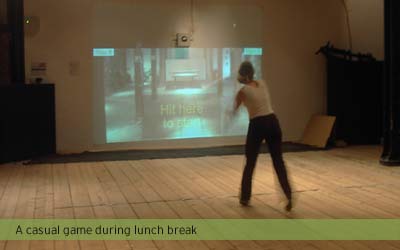Summary
Social interaction is an essential part of human communication, however the participants are often miles apart. Technological advances strive to bridge the physical distances between people, but generally lack the social potential offered through activities such as sports and games. An Exertion Interface combines the strength of both: the ability of sports to connect people socially, and the ability of telecommunications to connect people over a distance. By requiring intense physical effort from the participants, an Exertion Interface creates a better social bonding experience than traditional computer interfaces.
This assertion is tested through the creation of a system called "Breakout for Two", in which two remotely-located participants play a physically demanding ball game against each other while communicating through an overlaid life-size video-conference. A study with 56 participants showed that players who used the Exertion Interface played longer, said they got to know the other player better, had more fun, became better friends, and were happier with the transmitted audio and video quality in comparison to a control group playing the game with the same video-conferencing setup, but using a traditional keyboard interface. Exertion Interfaces, which are easy to learn, but hard to master, open a door to a new world of interfaces that facilitate social interaction between remote individuals.